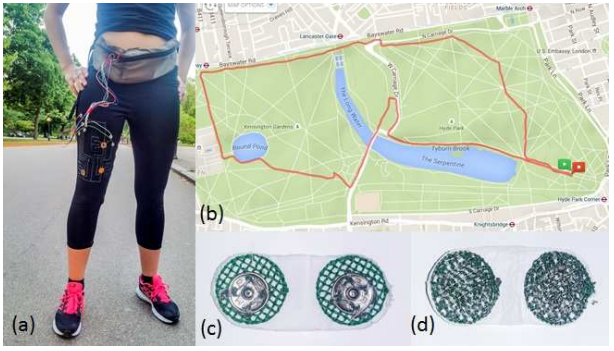Future Wearables: Intelligent Leggings Measure Muscle Fatigue in Runners
Wearable devices are changing the way people think about their lives and lifestyles. Smart watches are changing how we interact with each other, activity trackers are changing how we exercise, and wearable cameras are changing the nature of memory.
So what can we expect from the next generation of wearable electronic devices?
Today we get an answer of sorts thanks to the work of Roger Ribas Manero and pals at King’s College London. They’ve developed a wearable device that measures muscle fatigue during activities such as running, the first time this has been possible outside the lab.

Muscle fatigue has always been difficult to measure for a number of reasons. For a start, the most sensitive method involves inserting a fine wire into the muscle to measure the electrical stimulation of the nerves and determine the force the muscle can exert. As the muscle tires, this force drops, as does the electrical signal.
There is another, more flexible approach. This is to use electrodes on the surface of the skin to monitor the electrical activity of the nerves below. The problem with this method is that the electrodes have to be carefully placed and that’s hard for people who are not medically trained.
But neither technique is ideal for measuring muscle fatigue in ordinary circumstances because these devices can cost tens of thousands of dollars and in any case cannot be used outside the lab.
Now Ribas Manero and co have developed a significantly cheaper and more flexible alternative. Their idea is to embroider an ordinary pair runners leggings with electrodes and circuitry that connect to a portable Arduino microprocessor. This then collects and analyses the electrical stimulation data.
This circuitry is double stitched in a zigzag pattern to allow for stretching. And the entire device is powered by a 7.5-volt rechargeable battery.
This has a significant advantage for non-expert users. The embroidered circuit pattern ensures that the leggings automatically position the electrodes in the correct anatomical locations when they are worn. So the user needs no medical experience to position them. And the circuitry is relatively cheap and easy to produce.
The team has put the leggings through their paces by asking two runners to wear them while jogging around five-kilometer routes across three different surfaces—an asphalt track, an athletics track, and a sand track. The leggings recorded the muscle activity throughout.
The results make for interesting reading. The data clearly shows how the runner’s leg muscles begin to work harder, tire quickly after a minute or two and then get their second wind before tiring again. However, this tiring occurs quickly on sand, less quickly on asphalt, and least quickly on an athletics track.
That’s to be expected since sand’s instability make it more difficult to run on. But this is the first time that such an experiment has been done outdoors. And it has the potential to change the way athletes analyze the way they run.
Every runner hopes to compete without injury, but muscle fatigues makes this much more likely. So a way to measure and reveal fatigue in real time could have a major impact on training methods and running techniques. “[The data] suggests that running on sand increases the likelihood of suffering from RRIs when compared to the asphalt and athletics track surfaces,” say Ribas Manero and company.
What’s more, a better understanding of how muscles exert force could help in the design of better biomechanical prosthesis and in understanding power demands for bipedal robots.
And it could usher in a new era of wearable technologies that monitor not just the number of steps a person takes, but the muscles exerted in the process and how tired they become. Which is why intelligent leggings could be the next big wearable technology.
Ref: arxiv.org/abs/1602.04841: Wearable Embroidered Muscle Activity Sensing Device for the Human Upper Leg
Keep Reading
Most Popular
Large language models can do jaw-dropping things. But nobody knows exactly why.
And that's a problem. Figuring it out is one of the biggest scientific puzzles of our time and a crucial step towards controlling more powerful future models.
The problem with plug-in hybrids? Their drivers.
Plug-in hybrids are often sold as a transition to EVs, but new data from Europe shows we’re still underestimating the emissions they produce.
Google DeepMind’s new generative model makes Super Mario–like games from scratch
Genie learns how to control games by watching hours and hours of video. It could help train next-gen robots too.
How scientists traced a mysterious covid case back to six toilets
When wastewater surveillance turns into a hunt for a single infected individual, the ethics get tricky.
Stay connected
Get the latest updates from
MIT Technology Review
Discover special offers, top stories, upcoming events, and more.